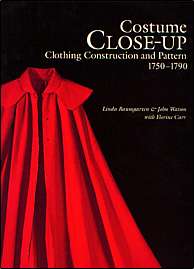Costume
Close-up: Clothing Construction and Pattern 1750-1790
By
Linda Baumgarten & John Watson with Florine Carr
QSM, 120 pages,
approx. 153 illustrations, softcover
Buy
Online
Reviewed by Nancy Lyons
Costume Close-up: Clothing Construction and Pattern 1750-1790 provides an in-depth history using examples of garments from the last half of the 18th century which are in the permanent collection of the Colonial Williamsburg Foundation in Williamsburg, Virginia, USA. Although a softcover book, it is well-illustrated with 94 vivid black and white and colour photos, 31 historic prints and 28 patterns (including construction techniques and embroidery details). Curators, conservators, costumers and period actors would find this book an informative read.
 |
Costume Close-up discusses the cut, fit and construction of 25 pieces or ensembles of clothing from England and France. The authors examined the stitch marks, thread remnants and creases to tell the story of how the clothing was made, altered, laundered and stored.
As the patterns were developed without taking the garments apart, the authors readily admit that there may be inaccuracies in measurements and incomplete construction notes. Adequately covering a broad spectrum across 40 years, some of the chapters describe "the gown, stomacher and petticoat", "cloak", "hoop petticoat", "waistcoat" and even the "stock".
Illustrated call out boxes give novice and expert alike further background about the clothing in their social context. After reading Costume Close-up, one understands how body shape and posture had been influenced by the clothing of the day. The authors point out that old garments indicate how people choose to spend their money, how they wanted to be seen, what they considered beautiful, and what was considered appropriate for their age and station in life. Side topics include: "how pinking was done", "fashionable cloaks", "holding up stockings", "cutting shirts", and "men's underwear".
Studying how period clothing was made also reveals much about the technology at the time. We are reminded that all sewing was done by hand, textiles were very expensive and scarce, and much clothing was fitted to the wearer's body while being made. Throughout the book, the authors bring to light interesting bits of information related to the producing, selling and wearing of these clothes. Some American men, for instance, ordered all the fabric, buttons and pocket linings for a suit from England and had them made by a local tailor.
Costume Close-up invites the reader to appreciate that unlike today, clothing was rarely discarded; rather salvaged, adapted and passed on whenever possible. It's a good thing, too, as these time-worn garments still provide fascination and enjoyment.